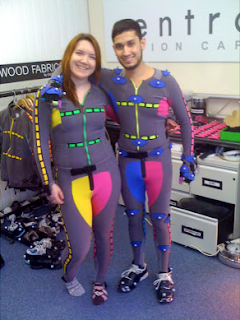Escape Studios animation tutor Amedeo Beretta joined us on Tuesday for a brand new webinar on Motion Capture animation. Amedeo's webinar explored the motion capture workflow, showing animators how to control animation when dealing with MoCap data in Autodesk Maya. Of all our animation tutors at Escape Studios, Amedeo has the most experience of handling motion capture data, taking the process from start to finish so that our students have usable, editable data that can be refined and tweaked during the animation process.
Performance Capture
Performance Capture, also known as Motion Capture, or "MoCap", is a growing part of the animation industry. It's something our students need to be able to work with effectively, as many animation studios - and especially games studios - rely heavily on MoCap for their animation pipeline.
 |
| MoCap at Escape Studios with Amedeo Beretta |
Motion Capture at Escape Studios
In December 2020 Motion Capture came to Escape Studios, as cinematographer and film-maker Clement Gharini tested out his new XSens MoCap suit on our student projects, working alongside Amedeo. The XSens MoCap system is one of the best on the market, offering a user-friendly solution to the challenges of motion capture hardware. MoCap expert and Escape Studios tutor Amedeo Beretta was on hand to process the data - a "soup to nuts" pipeline in which the MoCap performance was successfully captured and then re-targeted onto the students' animation rigs.MoCap Retargeting Tutorial at Vimeo Channel
Amedeo explains in detail the process of how to take a MoCap performance and re-target it onto an animation rig, so that the animation curves can be tweaked and polished.
You can find Amedeo's tutorial here. Like all our tutorials, it is password-protected, available for our current students and Escapees.
 |
| Amedeo Beretta |
It is a relatively straightforward process to capture MoCap data. The systems in place are for the most part well-tested and it doesn't take long to capture a performance.
However, once the performance is captured, the animator is faced with the tricky business of applying the data to their chosen animation rig, and doing so in a way that permits the animator to continue to tweak the performance.
Timing and spacing will need to be adjusted, and this means that the data must be correctly targeted onto the animation control curves, giving the user maximum flexibility to adapt the performance.
MoCap with Norman
 We also have a tutorial video by studio assistant Steve Lall, who demonstrates how to clean the original curves but, at the same time, not losing the essence of the original performance. Watch the video above, and you can see how Steve has used After Effects to create a "B panel" in the top right hand corner, showing what the original raw MoCap data looked like, in this case re-targeted onto the free Norman rig.
We also have a tutorial video by studio assistant Steve Lall, who demonstrates how to clean the original curves but, at the same time, not losing the essence of the original performance. Watch the video above, and you can see how Steve has used After Effects to create a "B panel" in the top right hand corner, showing what the original raw MoCap data looked like, in this case re-targeted onto the free Norman rig.The advantage of this approach is that it shows the animator's work process - any potential recruiter can see for themselves the original performance, and also understand what Steve has done with it to improve the animation and bring it to life.
Vimeo Channel
To find Steve's tutorial video at our Vimeo Channel, follow this link. Like our other tutorials, this one is password-protected. If you're a student or recent Escapee, email me for the password.
The Escape Studios Animation Blog offers a personal view on the art of animation and visual effects. To apply for our BA/MArt in 3D Animation, follow this link. To apply for our storyboarding evening class, visit this page here. For the next 12 week animation course, click here. And to apply for the next evening class in Producing Animation, see this page.


Thanks for sharing this Information. 3DS MAX Training Institute in Gurgaon
ReplyDelete